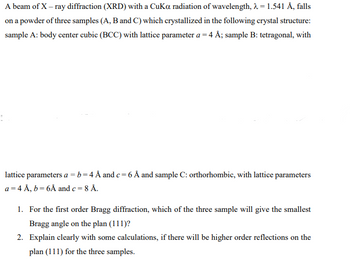Question

Transcribed Image Text:A beam of X-ray diffraction (XRD) with a CuKa radiation of wavelength, λ = 1.541 Å, falls
on a powder of three samples (A, B and C) which crystallized in the following crystal structure:
sample A: body center cubic (BCC) with lattice parameter a = 4 Å; sample B: tetragonal, with
lattice parameters a = b = 4 Å and c = 6 Å and sample C: orthorhombic, with lattice parameters
a = 4 Å, b = 6Å and c = 8 Å.
1. For the first order Bragg diffraction, which of the three sample will give the smallest
Bragg angle on the plan (111)?
2. Explain clearly with some calculations, if there will be higher order reflections on the
plan (111) for the three samples.
Expert Solution
This question has been solved!
Explore an expertly crafted, step-by-step solution for a thorough understanding of key concepts.
Step by stepSolved in 3 steps with 3 images

Knowledge Booster
Similar questions
- In designing an experiment, you want a beam of photons and a beam of electrons with thesame wavelength of 0.281 nm, equal to the separation of the Na and Cl ions in a crystal ofNaCl. Find the energy of the photons and the kinetic energy of the electrons in electrovolts(eV).arrow_forwardSome of the most powerful lasers are based on the energy levels of neodymium in solids, such as glass, as shown . (a) What average wavelength light can pump the neodymium into the levels above its metastable state? (b) Verify that the 1.17 eV transition produces1.06 μm radiation.arrow_forward